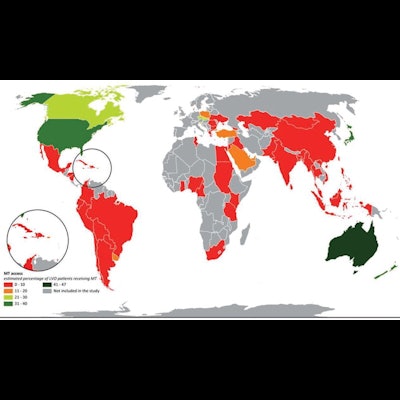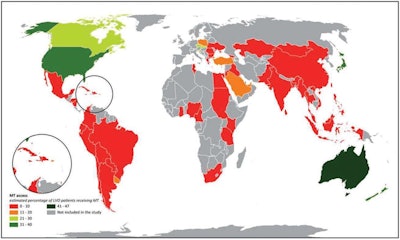
Patients worldwide have "dismal" access to mechanical thrombectomy (MT) -- a lifesaving standard of care procedure for certain strokes, according to a study published March 8 in Circulation.
In a first global survey exploring the issue in 67 countries, experts heading a campaign called Mission Thrombectomy 2020 Plus (MT2020+) found that just 2.79% of patients with large vessel occlusion (LVO) stroke receive mechanical thrombectomies.
"Access to MT for LVO stroke remains dismally low worldwide," a team led by Dr. Kaiz Asif of the University of Illinois Chicago wrote. "Global cooperation is needed to rapidly increase access to this brain and lifesaving and disability-sparing treatment."
Mechanical thrombectomy is the gold standard treatment for LVO. It is a type of minimally invasive endovascular therapy in which interventional radiologists remove blood clots from the brain after patients experience ischemic stroke. This restores blood flow and reduces damage to brain tissue.
MT2020+ is a global initiative launched in more than 80 countries in 2016 by the Society of Vascular and Interventional Neurology to improve patient access to mechanical thrombectomy. To date, comprehensive comparative global data on the access and delivery of mechanical thrombectomy are lacking, the group wrote.
 Estimated percentages of patients with large vessel occlusion (LVO) receiving mechanical thrombectomy (MT) are denoted by color. Image and caption courtesy of Circulation through CC BY 4.0.
Estimated percentages of patients with large vessel occlusion (LVO) receiving mechanical thrombectomy (MT) are denoted by color. Image and caption courtesy of Circulation through CC BY 4.0.In this study, the group conducted a survey of members of the MT2020+ global network in 75 countries between November 2020 and February 2021. Primary endpoints were current annual access to mechanical thrombectomy and the availability of staff who can perform the procedure and facilities that offer it. Access to mechanical thrombectomy was defined as the estimated proportion of patients with LVO undergoing it in a given region annually.
Asif and colleagues received 887 responses from 67 countries. Median global access to mechanical thrombectomy was 2.79%; in 18 countries, access was less than 1%; and in seven countries, access was 0%.
Most significantly, there was a 460-fold disparity between the highest and lowest mechanical thrombectomy access regions, and low-income countries had 88% lower access compared with high-income countries, the group wrote.
"Access to MT on a global level is extremely low, with enormous disparities between countries by income level," the group wrote.
Global cooperation and targeted region-specific public health interventions including all stakeholders involved in stroke care delivery are needed to increase access to the brain-saving and disability-sparing treatment of mechanical thrombectomy around the world, according to the authors.
To that end, the MT2020+'s global executive committee has published a white paper to educate policymakers, patients, caregivers, hospitals, device manufacturers, regulatory agencies, and providers about mechanical thrombectomy systems of care. It has also conducted workshops in low mechanical thrombectomy access areas.
"Global efforts to optimize stroke systems of care and decrease access disparities are urgently needed," the authors concluded.




















